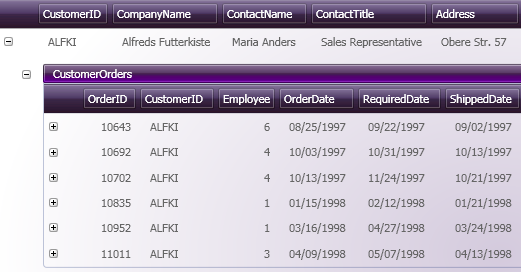
ExpandableFieldRecord objects are created to contain a child records collection. These child records are special because of their relationship to their parent record. They have a Field that relates every record in this child records collection with a field in the parent record that has the same value. Aside from this relationship, the child records can appear with a completely different field layout than their parent record.

The screen shot above illustrates how an expandable field record appears in xamDataGrid™ or xamDataPresenter™ using its Grid View. The relationship between the Customer record (at top) and the CustomerOrders records (shown in the expanded island) exists because their common CustomerID field value is the same ("ALFKI"). The field layout in the CustomerOrders records and Customer records is also different.
The following figure examines the make-up of an individual ExpandableFieldRecord object as it is presented in Grid View. Unlike the Data Record, remember that expandable field records serve as containers. Not all elements shown here may apply to you, depending on the settings you have configured on the control. This diagram will help you to understand how the parts of an expandable field record will be used when its corresponding Expandable Field Record Presenter displays it. For more information, see Presenters.

Whether an expansion indicator is shown in xamDataGrid, or a xamDataPresenter using the Grid View, depends upon the ExpandableFieldRecordExpansionMode property. It may be hidden completely, or shown only when there are multiple expandable field records (siblings) in the parent record’s child records collection.
Record headers (such as the "Customer Orders" header shown earlier) are not shown by default. If you have multiple ExpandableFieldRecord objects parented by the same data record, it may be useful for you to set the ExpandableFieldRecordHeaderDisplayMode to display record headers.
The Nested Content Site is where expandable content is situated using a Record List Control in Grid View. Its contents commonly consist of an Adorner object that will contain the Presenter objects responsible for displaying Field Label patterned on the layout defined in the Field Layout, and a virtualizing Panel object which will contain the Presenter objects responsible for displaying each child Data Record.